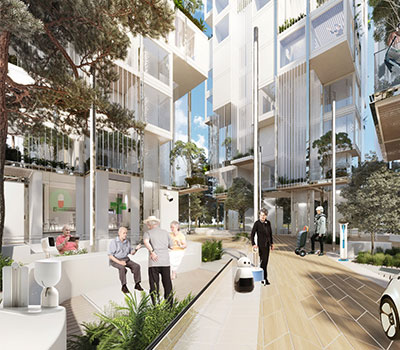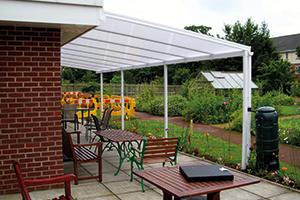With the summer in full swing and the recent pandemic situation, the need to spend time outdoors has never been so prevalent. We’ve therefore…
MMC: Making affordable homes for the elderly
Agile Ageing Alliance is a joining of innovators from across the building and housing sectors, as well as health, care, design & technology and finance advisors who have come together to produce a new way of retirement living. Neighbourhoods of the Future is a vision which modern methods of construction (MMC) can make a reality, providing much-needed affordable homes for the elderly as well as younger people. Here, Ian Spero – founder of Agile Ageing Alliance – answers editor Victoria Galligan's questions on how MMC can help to solve the housing crisis.
How many more affordable homes for the elderly are needed?
Today, there are more than 11 million people aged 65 and over in the UK, by 2035, there will be 17 million.
According to the Local Government Association, we are looking at a shortfall of more than 400,000 units of housing for older people by 2030
Modern Methods of Construction (MMC), emerging ‘smart’ technologies and big data analytics present possibilities for everyone. However, their potential impact on the way people, especially older adults, engage with the built environment is relatively unexplored. 
In a world where social networks are leading to a pandemic of loneliness, addressing the Ageing Society Challenge at a neighbourhood level should be a priority. Neighbourhoods are the settings where residents can socialise, realise common values, and achieve a level of social control and purpose.
Why is MMC a good choice compared to traditional methods?
The UK is facing an acute housing shortage. A better use of modern construction processes and materials could fix this, enabling thousands more homes to be built faster, cheaper and more efficiently; potentially transforming the quality and specificity of UK housing. Yet as things stand, our dependence on bricks and mortar defines a sector that is technologically moribund. Are there lessons to be learned from the successes of the automotive industry?
Writing in the Agile Ageing Alliance’s Neighbourhoods of the Future 2019, report – commissioned by Tata Steel, Kieran Singleton Co-founder, of automotive design specialists Forge Design – expands on this theme: “Car manufacturers first recognised the benefits of platform manufacturing decades ago. To make better products more affordable, it is standard practice in the automotive world to try and maximise the amount of inter-vehicle commonality. This level of standardisation could have led to a conveyor belt of similar products and a huge reduction in user choice. But, by aspiring to great design, manufacturers have taken advantage of the platform approach to deliver exciting new concepts, embraced by the public at both ends of the price spectrum.”
For our neighbourhoods of the future, the platform approach offers new opportunities for customised housing. This is particularly relevant for technologically enabled “adaptive” housing which can support independent living in later life.
Matt Cooper is a leading advocate for MMC at Arup, an independent firm of designers, planners, engineers, consultants and technical specialists which made its name as the designer and engineer behind some of the world’s most ambitious structures. According to Matt: “The creative pioneers of the new generation of MMC not only have the opportunity to alleviate our housing shortage but to change the way housing is delivered across the social spectrum. With adaptable and agile regeneration capabilities built in by design, within the next 10-20 years, MMC may not only halt the downward spiral in our housing market, but act as the catalyst for a new social economy.”
How are the units made accessible to people with mobility needs?
Making our homes more accessible to people with mobility needs is a pre-requisite for an ageing population. Let’s face it, our perception of space, the elements in our environment that we find restorative or tiring, helpful or strenuous, change as we age. This happens together with changes in our bodies.
New build housing and indeed retrofit homes can be made more accessible – and safer – by replacing steps with slopes/ramps, installing grabrails/handrails, trial installation of emerging new design of compact lifts, change floor coverings etc. Lighting can be improved to illuminate risk areas/install automated lighting (e.g. landings, motion/ pressure sensors when person gets out of bed). The bathroom is a top hazard area with regard to falls injury and could benefit from the use of non-slip flooring, lighting (as mentioned), taps/ other fittings as well as shower installation. Kitchen units can be lowered for easy reach from wheelchairs. Digital/ assistive technology measures have huge potential to improve lives. For some older people, it will be useful to offer an enhanced package such as the installation of sensors, alarm systems, automated use of environmental controls, the trial of new solutions, and/or innovative use of more mainstream systems such as Alexa etc.
Frankly, we are still scratching the surface of what we can do by combining better design, new products and interoperable systems and enabling technologies to empower people in later life. You can read more about retrofitting in a great article by Sue Adams OBE CEO of Care & Repair England in the aforementioned Neighbourhoods of the Future report
How do you envisage constructing enough units to meet this growing need?
A wholesale commitment to MMC and the aims and aspirations outlined in our report could make a substantive difference at scale. We are speaking with developers and local authorities around the country who are keen to do things differently. By way of example, a pioneering independent developer Regents Regeneration is planning to build a new multigenerational neighbourhood in Coventry. The exciting thing about the Regents scheme is they intend to build a factory outside of the City where they will construct the new homes off-site. Furthermore, the idea is to work with Coventry University to evaluate the impact on residents. The university also plans to incorporate a teaching facility to address a growing skills shortage in the construction market.
I will let Dr Evangelia Chrysikou, Healthcare Facilities Programme Director at UCL’s Bartlett Real Estate Institute, have the final word: “We must explain to people the benefits of inclusive societies. This needs to be taught in architectural schools where most students are younger than 25 years old and at that age are generally unable to imagine the physical or mental decline in older age. As a teacher I often use the paradigm of the Hippocratic Oath, a phrase that is cited by all physicians, insisting that it should equally apply to architects: “First do no harm. Then, try to do good”. These two lines, in that order, should support a new paradigm that all architects and professionals of the built environment should be aware of and incorporate in their practice
You can find out more about Agile Ageing Alliance here.





